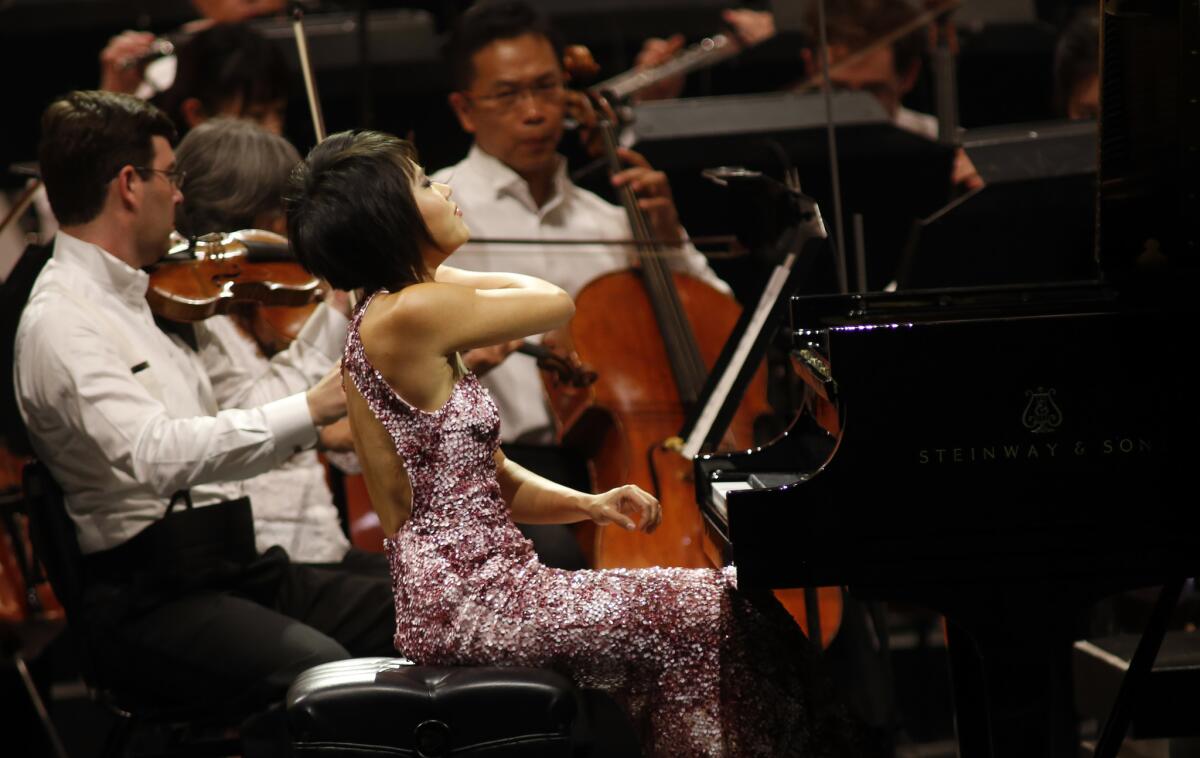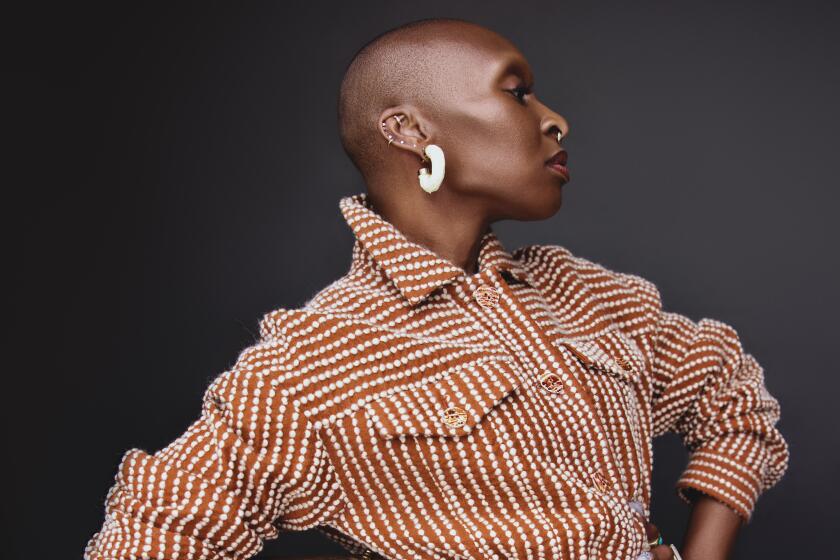Review: Dudamel and Wang deliver a ‘Rhapsody in Blue’ for the Hollywood Bowl history books

- Share via
All conductors, for seemingly inexplicable reasons, have their issues with certain composers, sometimes needing years to come to terms with their style or character. Leonard Bernstein struggled early in his career with making Mozart convincing, although he became great Mozartean later on. Esa-Pekka Salonen was not a Beethoven natural when he first came to Los Angeles, but he has matured into one of today’s most distinctively vibrant interpreters of the symphonies.
It’s hard to say why Gustavo Dudamel has struggled with Gershwin. Given Dudamel’s knack for American music, he gets the style and musical language. He can do the rhythms. He has all the technique in the world. Moreover, he has thrown himself into Gershwin, including conducting a 2011 Los Angeles Philharmonic Gershwin gala featuring jazz pianist Herbie Hancock. It was a rocky, unconvincing night.
Thursday, with Yuja Wang as Dudamel’s spectacular soloist in “Rhapsody in Blue” at the Hollywood Bowl, everything changed big time. This was a Gershwin performance for the Bowl history books, which have chapters devoted to all the composer’s greatest interpreters — Gershwin himself, Oscar Levant, Leonard Bernstein and Michael Tilson Thomas.
The program was devoted to Gershwin and Ravel. They were friends. Gershwin learned a lot about the orchestra and form from his French composer, 23 years his senior. Ravel learned how to loosen up from Gershwin, and the evening’s two Ravel works — the Piano Concerto in G, also with Wang as soloist, and “Boléro” — are among his most successfully jazz-tinged.
It was a summery show. A warm evening began with “Catfish Row,” Gershwin’s five-movement symphonic suite from “Porgy and Bess.” A banjo twangs, an upright piano adds beer-hall flavor, a solo violin (movingly played by Martin Chalifour) sentimentalizes “Summertime.” The opera’s hurricane blew hard through the orchestra. Dudamel had the swing. That it didn’t mean enough of a thing may have been more the result of the score than the conductor. This suite has never caught on. The orchestration is fussy, the drama heavy of hand, none of which Dudamel questioned. A “Porgy and Bess,” however, could well be in Dudamel’s future.
If Gershwin awkwardly attempted a Ravelian orchestral model with “Catfish Row,” Ravel nailed a jazzy French style with his Concerto in G. It is a Wang specialty. Wearing one of her trademark colorful gowns, she offered a spectacularly sparkling performance, full of snap. She made of the slow movement an elegant blues. Dudamel was attentive to her every whim.
But the sparks didn’t fly until after intermission with the “Rhapsody in Blue.” We could fight forever whether this is a jazz piece or a classical concerto. Gershwin had it both ways, originally writing it for Paul Whiteman’s band playing in Carnegie Hall and then adapting it to suit a more traditional symphony orchestra. The modern approach is to make the symphony orchestra lean and jazz-worthy.
With an enormous orchestra filling the Bowl stage, Dudamel found an ideal balance between two worlds. He also had in Wang a pianist able to merge those worlds with an astonishing brilliance. I can’t say I saw it coming that the Chinese pianist would be so persuasive a Gershwin player. It may help that she’s had mentoring from Tilson Thomas. But this is also one of those composer-performer relationships that simply click.
She dressed the part, changing into a glittery blue short skirt and perilously high spiked heels, seemingly an ergonomic disaster for pedaling that she somehow overcame. But for all the attention Wang attracts, she is a cool customer. Maybe that is her Gershwin secret, along with her unerring technique and musicality.
She played long solo jazz passages with the kind of nonchalance that Gershwin displayed at the keyboard. She flirted with the keys in lyrical passages. The video cameras got carried away with tight facial shots, showing her sly satisfaction with nailing virtuosic passages rather than her fabulous fingerwork.
What appeared on screens seemed better suited for glossy fashion shoots, but there was something far less trivial happening on the Bowl stage and being amplified through the sound system. Wang and Dudamel together quarried every over-familiar, over-mined inch of “Rhapsody in Blue” for something startling fresh.
In Dudamel’s hands, the extra large orchestra was both plaything and tool. He could expose grandeur yet, by keeping a big band arrestingly light, he avoided any sense of overblowing jazz. This was not unlike his unique blend of Broadway and opera in “West Side Story” on his previous Bowl nights. With Wang as just the Gershwin guide Dudamel has always needed, he remained thrillingly responsive to her while magnifying and intensifying her explosive implications.
When it came to trying to turn the pages on Wang’s iPad for her encore, Nikolai Kapustin’s Toccantina, Dudamel threw his hands up in the air and let Chalifour do it.
On the other hand, “Boléro” has always belonged to Dudamel, and Thursday’s performance was a study in maturation, from stillness to rapture. The L.A. Phil offered a series of gloriously suave solos, but the feeling was of one long line and grand crescendo unbroken. Colors and volume change, but the path is sure, as a showpiece becomes a road map for constancy in an environment of certainty.
More to Read
The biggest entertainment stories
Get our big stories about Hollywood, film, television, music, arts, culture and more right in your inbox as soon as they publish.
You may occasionally receive promotional content from the Los Angeles Times.











